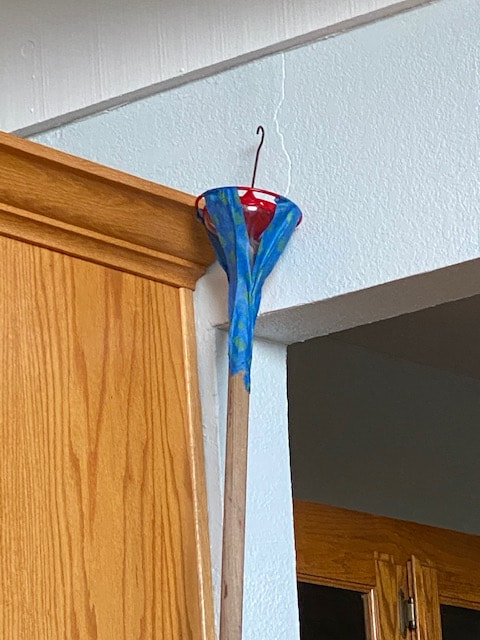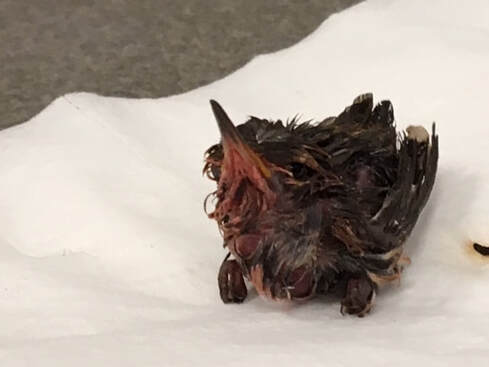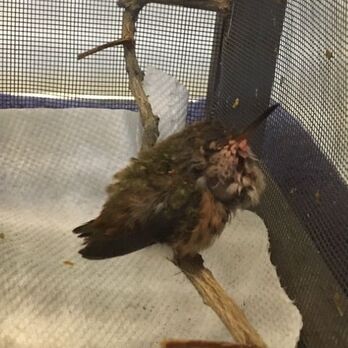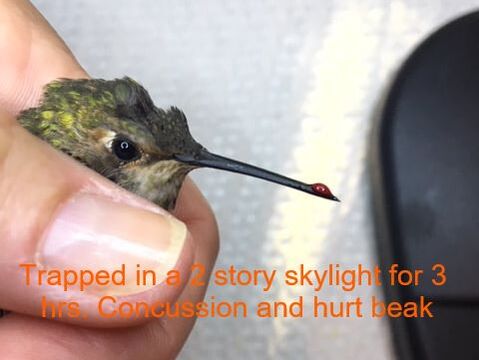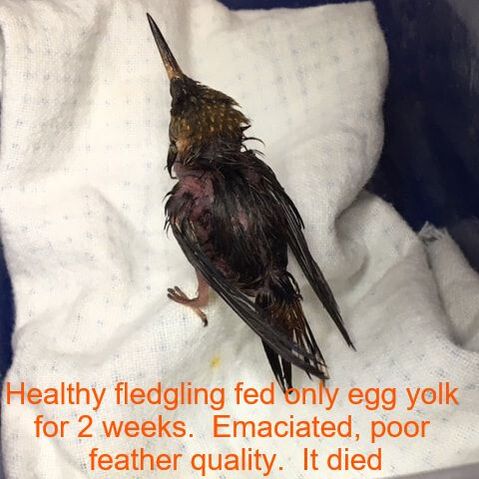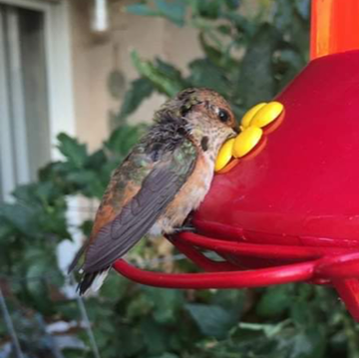Birds that need to go to a rehabilitator:
#1 Has been in a cat's mouth
#2 Has bugs on it (mites or ants)
#3 Bleeding
#4 Injured (ex: wing doesn't work, can't close mouth, beak broken, can't perch, sores on beak, feet or wings)
#5 Trapped in building for 2 hours, flying constantly and without food, or trapped and ends up on the ground from exhaustion.
#6 Can't fly
#7 Hit a window and being "stunned" lasts for more than 1 minute.
#8 Orphan (confirmed by watching for mom for 30 minutes without looking away), or mom is confirmed dead
#9 Trouble breathing
#10 Has sticky or oily substance on it
#1 Has been in a cat's mouth
#2 Has bugs on it (mites or ants)
#3 Bleeding
#4 Injured (ex: wing doesn't work, can't close mouth, beak broken, can't perch, sores on beak, feet or wings)
#5 Trapped in building for 2 hours, flying constantly and without food, or trapped and ends up on the ground from exhaustion.
#6 Can't fly
#7 Hit a window and being "stunned" lasts for more than 1 minute.
#8 Orphan (confirmed by watching for mom for 30 minutes without looking away), or mom is confirmed dead
#9 Trouble breathing
#10 Has sticky or oily substance on it
COMMON PROBLEMS
I have a hummingbird trapped in my house (garage, barn, warehouse, shop).
Hummingbirds go up, and to light....always. They will not go from a 2nd story window and seek out a first story door or window from which to exit. So, if they are flying around in a skylight, or a high window, that is where they expect to find their way out. They fly and fly and fly and fly until they are exhausted. Hummingbirds feed constantly, so to fly and fly without a source of calories, they get hypoglycemic (low blood sugar) and eventually perch and die, or fall to the ground and die.
In a one story building: open all the doors and windows. Turn off all the lights. Often if they see sunlight, they will head for that and leave. Putting something red by the door helps too, especially if it is a feeder.
Taller rooms: attach a hummingbird feeder (with a perch on it) to the handle of a broom. I use blue painter's tape. Add sugar water (4 parts water: 1 part white sugar) and hold the feeder at the level of the bird. If it is below the bird, it may not see it. They are frantic to escape and not thinking clearly. Once it sees the feeder, it will eventually perch and drink. Let it eat and rest. After a bit, while the bird is perching on the feeder, lower the broom and take it and the bird outside. Leave the feeder outside for the bird to have so it can continue to feed.
***IF THE BIRD IS EXHAUSTED, hold it in your warm hand for 10 full minutes, then put it in a box and continue to warm it. You can do this by putting 1 cup of rice in a sock and microwave for 1 minute. Cover the warm sock with a rag and put that in the box by the bird. (If you don't have rice you can put very warm water in a water bottle and cover it with a rag and place by the bird. Be sure the bottle doesn't roll. Offer a little sugar water after it is warm and alert. These birds may be able to fly a little, but cannot survive, especially if the weather is cold or it is almost nighttime. Please call a rehabber for advice.
DO NOT RELEASE A HUMMINGBIRD THAT HAS BEEN TRAPPED AND FALLEN TO THE GROUND. THEY NEED MORE THAN A LITTLE REST AND SOME SUGAR WATER! Please, this is correctable, but it sometimes takes days before they are competent to take care of themselves after they have collapsed. Just because they can fly far enough to escape you, doesn't mean they are capable of finding food and warmth. These birds need a ride to a rehabber. Please.
Hummingbirds go up, and to light....always. They will not go from a 2nd story window and seek out a first story door or window from which to exit. So, if they are flying around in a skylight, or a high window, that is where they expect to find their way out. They fly and fly and fly and fly until they are exhausted. Hummingbirds feed constantly, so to fly and fly without a source of calories, they get hypoglycemic (low blood sugar) and eventually perch and die, or fall to the ground and die.
In a one story building: open all the doors and windows. Turn off all the lights. Often if they see sunlight, they will head for that and leave. Putting something red by the door helps too, especially if it is a feeder.
Taller rooms: attach a hummingbird feeder (with a perch on it) to the handle of a broom. I use blue painter's tape. Add sugar water (4 parts water: 1 part white sugar) and hold the feeder at the level of the bird. If it is below the bird, it may not see it. They are frantic to escape and not thinking clearly. Once it sees the feeder, it will eventually perch and drink. Let it eat and rest. After a bit, while the bird is perching on the feeder, lower the broom and take it and the bird outside. Leave the feeder outside for the bird to have so it can continue to feed.
***IF THE BIRD IS EXHAUSTED, hold it in your warm hand for 10 full minutes, then put it in a box and continue to warm it. You can do this by putting 1 cup of rice in a sock and microwave for 1 minute. Cover the warm sock with a rag and put that in the box by the bird. (If you don't have rice you can put very warm water in a water bottle and cover it with a rag and place by the bird. Be sure the bottle doesn't roll. Offer a little sugar water after it is warm and alert. These birds may be able to fly a little, but cannot survive, especially if the weather is cold or it is almost nighttime. Please call a rehabber for advice.
DO NOT RELEASE A HUMMINGBIRD THAT HAS BEEN TRAPPED AND FALLEN TO THE GROUND. THEY NEED MORE THAN A LITTLE REST AND SOME SUGAR WATER! Please, this is correctable, but it sometimes takes days before they are competent to take care of themselves after they have collapsed. Just because they can fly far enough to escape you, doesn't mean they are capable of finding food and warmth. These birds need a ride to a rehabber. Please.
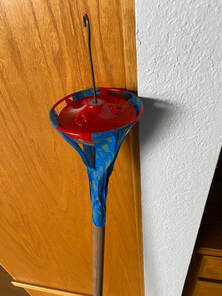
Hummingbird feeder attached to top of a broom.
Other feeders can be placed on the side (not top) of the broom.
If you don't have a feeder, try to borrow one or get from a hardware store. This is the best option. If the bird has only been in the house for an hour, you can drape a red towel, jacket, or super-hero cape over the bristle end of the broom. Wait for the bird to land and take it outside.
Other options are to cover the skylight or windows, make the room dark and hope the bird goes toward an open door or window (where he can see sunlight).
If the bird collapses to the floor, IT IS NOT RELEASABLE. Consider yourself, running a 20K and collapsing at the finish line, dehydrated, hungry and exhausted. No one would expect you to pick yourself up after a glass of Gatorade and resume your normal day. You need rest, hydration, calories. So does this bird. It needs to be warmed in your hand for 10 minutes, offered sugar water on a q-tip (if you give it in a straw or syringe, the bird will gulp and because it is so weak, the fluid will go into it's lungs and it could die in your hand). After warming and feeding, put in a box, place in on a heating pad (or give it a rice sock) and call a rehabber. Keep it warm. If it gets cold again, they usually die.
Other feeders can be placed on the side (not top) of the broom.
If you don't have a feeder, try to borrow one or get from a hardware store. This is the best option. If the bird has only been in the house for an hour, you can drape a red towel, jacket, or super-hero cape over the bristle end of the broom. Wait for the bird to land and take it outside.
Other options are to cover the skylight or windows, make the room dark and hope the bird goes toward an open door or window (where he can see sunlight).
If the bird collapses to the floor, IT IS NOT RELEASABLE. Consider yourself, running a 20K and collapsing at the finish line, dehydrated, hungry and exhausted. No one would expect you to pick yourself up after a glass of Gatorade and resume your normal day. You need rest, hydration, calories. So does this bird. It needs to be warmed in your hand for 10 minutes, offered sugar water on a q-tip (if you give it in a straw or syringe, the bird will gulp and because it is so weak, the fluid will go into it's lungs and it could die in your hand). After warming and feeding, put in a box, place in on a heating pad (or give it a rice sock) and call a rehabber. Keep it warm. If it gets cold again, they usually die.
I have a hummingbird sitting on my feeder and it doesn't fly away.
If the bird is not leaving, there is a problem. It could be hurt or sick. If it is hanging upside down, while all the other birds are flying around, that's a problem. Prepare a box (see fledglings) and gently remove the bird from the feeder. Approach from behind and gently close your fingers around it. Do NOT pull straight back. When they are unconscious, they lock their toes around a perch to keep from going to the ground. Tug gently left than right and let one foot release at a time. Warm the bird and feed a little. Do this is the bathroom in case it gets a burst of energy (you are a predator and it's afraid of you). It is easier to catch a hummingbird in a bathroom than in a living room. Contact a rehabber.
If the bird is not leaving, there is a problem. It could be hurt or sick. If it is hanging upside down, while all the other birds are flying around, that's a problem. Prepare a box (see fledglings) and gently remove the bird from the feeder. Approach from behind and gently close your fingers around it. Do NOT pull straight back. When they are unconscious, they lock their toes around a perch to keep from going to the ground. Tug gently left than right and let one foot release at a time. Warm the bird and feed a little. Do this is the bathroom in case it gets a burst of energy (you are a predator and it's afraid of you). It is easier to catch a hummingbird in a bathroom than in a living room. Contact a rehabber.
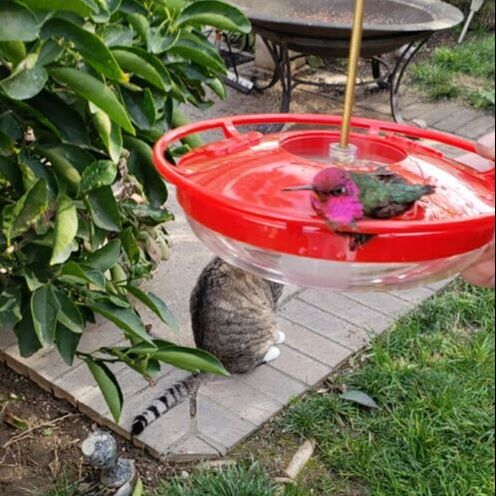
This is an injured adult male Anna's hummingbird. It was able to make it to a feeder, but it's wing injury wouldn't allow it to hover. At some point another hummingbird will attack it and force it off the feeder. It will go to the ground, where there is a cat, waiting. You can guess how it will end. Also, other birds (crows especially) could go after it.
Feeders and outdoor cats are not compatible. If you must have an outdoor cat, please, please remove your feeders. It's not fair.
Feeders and outdoor cats are not compatible. If you must have an outdoor cat, please, please remove your feeders. It's not fair.
A hummingbird hit my window and it is not moving.
If the bird is there for more than a minute, go pick it up and hold it in your warm hands. Prepare a box and warm it (see fledglings). DO NOT FEED IT. It is hurt, not hungry. Contact a rehabber. Even if it starts moving around in the box, call for advice and do not release it. Head injured birds may look ok, but they are not thinking straight and need many days to recover. Imagine you hitting a wall, 35 mph no seat belt. At the very least you would have a bad headache and neck pain. So do they.
If the bird is there for more than a minute, go pick it up and hold it in your warm hands. Prepare a box and warm it (see fledglings). DO NOT FEED IT. It is hurt, not hungry. Contact a rehabber. Even if it starts moving around in the box, call for advice and do not release it. Head injured birds may look ok, but they are not thinking straight and need many days to recover. Imagine you hitting a wall, 35 mph no seat belt. At the very least you would have a bad headache and neck pain. So do they.
A hummingbird has something sticky on it, and can't fly well, or at all.
Hummingbirds move quickly and sometimes they brush up against things that are sticky. Examples: oriole jelly, Vaseline, sugar water, spider webs, glue, tape, oil.
These birds must stay warm and they do this by being a closed unit of multi-layers of feathers. If feathers are missing, stuck together, crusty, oily or covered with webs and debris, they are not able to thermoregulate, or fly well. These birds need to be cleaned by someone who knows what they are doing, kept warm, fed and given time to get their feathers in good working order.
Perils: oriole jelly that can come in contact with birds
Vaseline on feeders (use an ant moat, do not grease up the feeder poles, or shepherds poles that hold the feeders)
No open containers of sugar water, ever.
Remove spider webs near feeders if you see them.
Never ever use glue traps. They are a painful and a horrible tortured death for any creature.
Fly tape, or any tape in the flight areas is a bad idea.
All containers of oil should be covered, for the safety of all birds.
Hummingbirds move quickly and sometimes they brush up against things that are sticky. Examples: oriole jelly, Vaseline, sugar water, spider webs, glue, tape, oil.
These birds must stay warm and they do this by being a closed unit of multi-layers of feathers. If feathers are missing, stuck together, crusty, oily or covered with webs and debris, they are not able to thermoregulate, or fly well. These birds need to be cleaned by someone who knows what they are doing, kept warm, fed and given time to get their feathers in good working order.
Perils: oriole jelly that can come in contact with birds
Vaseline on feeders (use an ant moat, do not grease up the feeder poles, or shepherds poles that hold the feeders)
No open containers of sugar water, ever.
Remove spider webs near feeders if you see them.
Never ever use glue traps. They are a painful and a horrible tortured death for any creature.
Fly tape, or any tape in the flight areas is a bad idea.
All containers of oil should be covered, for the safety of all birds.
Rehabilitators - if you need help, call a permitted rehabilitator. Do not ask a vet, as most do not know much about hummingbirds. Do not go to a pet store, or to a friend with a parakeet, not animal control or a feed store, not your neighbor (unless he or she is a rehabber). Use the information under Contacts to find someone qualified to help.
Birds keep running into my windows.
Picture windows can be death traps for birds. Be sure to locate feeders at least 5 feet from windows. Feeders that attach to windows are dangerous for hummingbirds. It may be fun for you to be that close, but if another dominant bird attacks, a younger bird may strike your window, trying to get away.
Among other measures you can take are to cover window glass with netting or transparent film, or place decals, stickers or other objects on the outside surface of the window. It is important to note that placing just one or two window stickers on a large window is not going to prevent collisions. They must cover most of the glass with the spaces between too narrow for birds to fly through. The Cornell Lab of Ornithology has more ideas for helping birds avoid window collisions.
www.allaboutbirds.org/news/why-birds-hit-windows-and-how-you-can-help-prevent-it
Amazon sells "window alert" decals that look nice and are an outline of a hummingbird.
Intense weather, freezing temperatures and snow are causing birds to become unconscious and die, or stick to feeders due to ice.
Please visit this website and go to "blog" for excellent information: nativebirdcare.org
Click on this link for a video on how to slowly and appropriately warm these birds before releasing or taking to a rehabber. youtu.be/VkL7NH3spb8
Picture windows can be death traps for birds. Be sure to locate feeders at least 5 feet from windows. Feeders that attach to windows are dangerous for hummingbirds. It may be fun for you to be that close, but if another dominant bird attacks, a younger bird may strike your window, trying to get away.
Among other measures you can take are to cover window glass with netting or transparent film, or place decals, stickers or other objects on the outside surface of the window. It is important to note that placing just one or two window stickers on a large window is not going to prevent collisions. They must cover most of the glass with the spaces between too narrow for birds to fly through. The Cornell Lab of Ornithology has more ideas for helping birds avoid window collisions.
www.allaboutbirds.org/news/why-birds-hit-windows-and-how-you-can-help-prevent-it
Amazon sells "window alert" decals that look nice and are an outline of a hummingbird.
Intense weather, freezing temperatures and snow are causing birds to become unconscious and die, or stick to feeders due to ice.
Please visit this website and go to "blog" for excellent information: nativebirdcare.org
Click on this link for a video on how to slowly and appropriately warm these birds before releasing or taking to a rehabber. youtu.be/VkL7NH3spb8
Top Mistakes made by well-meaning rescuers:
#1 Picking up a fledgling .
Fledglings leave the nest intentionally at 21-24 days of age. They have spent their entire lives in a nest, so cannot fly fast or well. Their aim isn't good either. They run into things, they end up on patio chairs, streets, backs of trucks, lawns, lawn chairs, pools. Whatever was near their nest when they jumped (fledged). They are easy to catch and have no fear of humans, or dogs, or cats. Kind hearted folks see a baby hummingbird in any of these places and think they "fell" out of their nest, so they try to re-nest them, or take them in and feed them. (or take it to work with them, or lock it in a room and then go to work, or keep it and feed it the wrong food, which eventually leads to it's death). The appropriate action is to PUT IT BACK. The mother is there looking for it, waiting to feed it, defend it, and train it. Please do not interrupt this. There are exceptions, so please call a rehabber, or email me and ask for advice.
Fledglings leave the nest intentionally at 21-24 days of age. They have spent their entire lives in a nest, so cannot fly fast or well. Their aim isn't good either. They run into things, they end up on patio chairs, streets, backs of trucks, lawns, lawn chairs, pools. Whatever was near their nest when they jumped (fledged). They are easy to catch and have no fear of humans, or dogs, or cats. Kind hearted folks see a baby hummingbird in any of these places and think they "fell" out of their nest, so they try to re-nest them, or take them in and feed them. (or take it to work with them, or lock it in a room and then go to work, or keep it and feed it the wrong food, which eventually leads to it's death). The appropriate action is to PUT IT BACK. The mother is there looking for it, waiting to feed it, defend it, and train it. Please do not interrupt this. There are exceptions, so please call a rehabber, or email me and ask for advice.
#2 Not finding help quickly.
When a bird is kept for hours or days, the chances of a recovery are lessened. Rehabbers have medications, appropriate diet, correct caging and knowledge of how to help the bird. I have lost so many birds due to finders keeping them for too long. They bring them to me too late. So often I could have helped.
#3 Incorrect feeding or feeding when the bird is semi-conscious.
Feeding a bird that is cold and lethargic (puffy, eyes closed) often leads to aspiration. This is when the sugar water goes into the lungs and the bird suffocates. They are just like an unconscious or semi-conscious human who cannot control his airway. You wouldn't force water on an unconscious human would you? Please don't do it to a bird. It often leads to immediate death or extreme respiratory distress, which is irreversible. They must be warm and alert prior to feeding. And even then, just very small amounts. Gulping makes the fluid go into the lungs.
Feeding a bird that is cold and lethargic (puffy, eyes closed) often leads to aspiration. This is when the sugar water goes into the lungs and the bird suffocates. They are just like an unconscious or semi-conscious human who cannot control his airway. You wouldn't force water on an unconscious human would you? Please don't do it to a bird. It often leads to immediate death or extreme respiratory distress, which is irreversible. They must be warm and alert prior to feeding. And even then, just very small amounts. Gulping makes the fluid go into the lungs.
#4 Releasing an injured bird.
A bird trapped in a house for hours needs more than a few sips of sugar water. He needs to be warmed up and given sips of sugar water. If he doesn't improve quickly, he should not be released. Just because they can fly doesn't mean they will survive.
A bird caught by a cat needs antibiotics.
A bird that was in your pool needs to be warmed and fed and observed to be sure it didn't inhale water.
A bird that hits a window and is unconscious is just like a human who has a head injury and concussion. If you were unconscious, you go to the ER, they do an MRI, they observe you for many hours, they treat the pain and the nausea. They send you home with instructions for your loved one to check you throughout the night and if you are not thinking straight, to bring you right back. Birds are no different when they get a concussion. They are confused, dizzy, no appetite. They need time for their brains to heal so that they can survive.
#5 DIY rehab.
There is so much bad information on the internet. That is why I'm doing this website. It's been reviewed by other rehabbers to be sure of accuracy. If you watch You Tube videos and research random sites you will find a lot of misinformation that will kill hummingbirds. Figure out who is writing the information before you take it as truth.
There is so much bad information on the internet. That is why I'm doing this website. It's been reviewed by other rehabbers to be sure of accuracy. If you watch You Tube videos and research random sites you will find a lot of misinformation that will kill hummingbirds. Figure out who is writing the information before you take it as truth.
#6 Dirty feeders.
Hummingbird feeders are a little bit of work. They must be cleaned every time you change the sugar water. If you see mold, or if the solution is slimy, you are not changing and cleaning often enough. Consider a dog's water dish. Each time he drinks, some of his saliva enters the water. You can see it. This is true with feeders. Multiple birds use the feeders and each time they drink, they leave a little of their saliva in it. Add heat from the sun, and in a few days, you have a container of sugar water that is growing bacteria and fungus. One sick bird will contaminate the feeder, time and heat from the sun will make the germs grow. This sickens the birds.
Please keep the feeders clean and do not use store bought food. 4 parts water to 1 part sugar, make your own and keep it in the refrigerator for no more than 2 weeks. Its cheap and easy, and much better for the birds. Use regular white granulated sugar. Organic sugar, even though it sounds healthier, has molasses in it (hence the yellow color). Molasses is not good for them. White sugar is the closest we can get to pure sucrose.
Did you know the birds I receive who were given red dye in the sugar water, pee red for two days?? The dye is unnecessary and potentially dangerous.
Hummingbird feeders are a little bit of work. They must be cleaned every time you change the sugar water. If you see mold, or if the solution is slimy, you are not changing and cleaning often enough. Consider a dog's water dish. Each time he drinks, some of his saliva enters the water. You can see it. This is true with feeders. Multiple birds use the feeders and each time they drink, they leave a little of their saliva in it. Add heat from the sun, and in a few days, you have a container of sugar water that is growing bacteria and fungus. One sick bird will contaminate the feeder, time and heat from the sun will make the germs grow. This sickens the birds.
Please keep the feeders clean and do not use store bought food. 4 parts water to 1 part sugar, make your own and keep it in the refrigerator for no more than 2 weeks. Its cheap and easy, and much better for the birds. Use regular white granulated sugar. Organic sugar, even though it sounds healthier, has molasses in it (hence the yellow color). Molasses is not good for them. White sugar is the closest we can get to pure sucrose.
Did you know the birds I receive who were given red dye in the sugar water, pee red for two days?? The dye is unnecessary and potentially dangerous.
#7 Outdoor cats when you know there is a nest in your yard.
Cats kill over a billion birds a year in America. Google it. Every baby season I get nests of babies from people who know they have a nest in their yard and still let their cat outside. Their cat kills the mom and I get to raise the babies. My diet is good, but not as good as the mother's. Sometimes I get the babies as they fledge and the cat brings them in as a prize. These people are devastated because they have watched the babies grow since they were hatched. Most cat caught birds don't survive, but I try.
abcbirds.org/program/cats-indoors/trap-neuter-release/
Cats kill over a billion birds a year in America. Google it. Every baby season I get nests of babies from people who know they have a nest in their yard and still let their cat outside. Their cat kills the mom and I get to raise the babies. My diet is good, but not as good as the mother's. Sometimes I get the babies as they fledge and the cat brings them in as a prize. These people are devastated because they have watched the babies grow since they were hatched. Most cat caught birds don't survive, but I try.
abcbirds.org/program/cats-indoors/trap-neuter-release/
#8 Deciding to keep it as a pet.
Native wildlife (which includes hummingbirds) are the property of the State of California. It is illegal to make pets of them. To rehab them, one must have a state and federal permit. They are meant to be free and wild and to give us joy. An injured, un-flighted hummingbird is a frustrated bird.
A baby hummingbird, in the hands of someone who is trying to "raise" them, usually does not do well. Their diet is very specific as well as their training. Some folks raise them on sugar water until they can fly and then release them thinking they will do ok. They do not. They are malnourished (would you feed your kid only sugar water??) They often have fractures from the poor nutrition.
They need to learn to recognize which flowers contain nectar to give them energy, how to catch bugs, work on strengthening their flight muscles, where to sleep, etc. Mom teaches them these things. Releasing a fledgling without training is a death sentence. They will fly a little ways, then perch and cry, and cry, and cry for their mom, until they die. They may fly out of your yard, so you may not hear them cry.
Native wildlife (which includes hummingbirds) are the property of the State of California. It is illegal to make pets of them. To rehab them, one must have a state and federal permit. They are meant to be free and wild and to give us joy. An injured, un-flighted hummingbird is a frustrated bird.
A baby hummingbird, in the hands of someone who is trying to "raise" them, usually does not do well. Their diet is very specific as well as their training. Some folks raise them on sugar water until they can fly and then release them thinking they will do ok. They do not. They are malnourished (would you feed your kid only sugar water??) They often have fractures from the poor nutrition.
They need to learn to recognize which flowers contain nectar to give them energy, how to catch bugs, work on strengthening their flight muscles, where to sleep, etc. Mom teaches them these things. Releasing a fledgling without training is a death sentence. They will fly a little ways, then perch and cry, and cry, and cry for their mom, until they die. They may fly out of your yard, so you may not hear them cry.
#9 Sharing incorrect information on social media.
There are many social media sites for hummingbird enthusiasts. Occasionally someone will find a hurt bird and ask for help. The advice given is often wrong. If you have a question, find a rehabilitator, or send me an e-mail. I'll be happy to help.
There are many social media sites for hummingbird enthusiasts. Occasionally someone will find a hurt bird and ask for help. The advice given is often wrong. If you have a question, find a rehabilitator, or send me an e-mail. I'll be happy to help.
#10 Taking pictures of a nest or using a flash while photographing hummingbirds.
Some folks like to take pictures of a mom on a nest. Or of the nest when she is away finding food. She is trying to be stealthy and not attract predators. Humans who keep going over to where she has hidden her eggs/babies, attract unwanted attention. Crows are smart, so are squirrels. They both eat baby birds. Please do not give away the location of her nest.
Better to only take pictures using a telephoto lens.
Some folks like to take pictures of a mom on a nest. Or of the nest when she is away finding food. She is trying to be stealthy and not attract predators. Humans who keep going over to where she has hidden her eggs/babies, attract unwanted attention. Crows are smart, so are squirrels. They both eat baby birds. Please do not give away the location of her nest.
Better to only take pictures using a telephoto lens.
#11 Putting Vaseline on a feeder to discourage ants.
Any substance that can cause decreased feather quality should not be used. Vaseline seems to be popular for feeder posts and shepherds poles. There are feeders with built in ant moats and some low cost ant moats you can get on Amazon. Please use those. They sometimes perch on those poles or get bumped into the posts by another faster bird then get the Vaseline on their feathers. Messy feathers do not keep them warm or aerodynamic. If they try to preen off the Vaseline, they swallow it and it interferes with their digestion.
Any substance that can cause decreased feather quality should not be used. Vaseline seems to be popular for feeder posts and shepherds poles. There are feeders with built in ant moats and some low cost ant moats you can get on Amazon. Please use those. They sometimes perch on those poles or get bumped into the posts by another faster bird then get the Vaseline on their feathers. Messy feathers do not keep them warm or aerodynamic. If they try to preen off the Vaseline, they swallow it and it interferes with their digestion.
.
#12 Buying cheap feeders.
The best feeders are ones that are easily cleaned, have a built in ant moat, and have a perch. There should be only one perch and it should be 3/4" from the feeder hole. Ones with very close perches cause the long beak of the bird to sometimes get stuck in the port and they can't get away.
#12 Buying cheap feeders.
The best feeders are ones that are easily cleaned, have a built in ant moat, and have a perch. There should be only one perch and it should be 3/4" from the feeder hole. Ones with very close perches cause the long beak of the bird to sometimes get stuck in the port and they can't get away.
#13 Trimming trees when there are nests.
Hummingbirds start nesting in December and the last of the young usually fledge by August. The best time to trim trees and bushes in October and November. If you must trim, look carefully for nests. If you are trimming and a hummingbird starts buzzing and dive-bombing you, this is probably the mother trying to get you to stop. Pay attention to her and stop.
Hummingbirds start nesting in December and the last of the young usually fledge by August. The best time to trim trees and bushes in October and November. If you must trim, look carefully for nests. If you are trimming and a hummingbird starts buzzing and dive-bombing you, this is probably the mother trying to get you to stop. Pay attention to her and stop.
Proudly powered by Weebly
